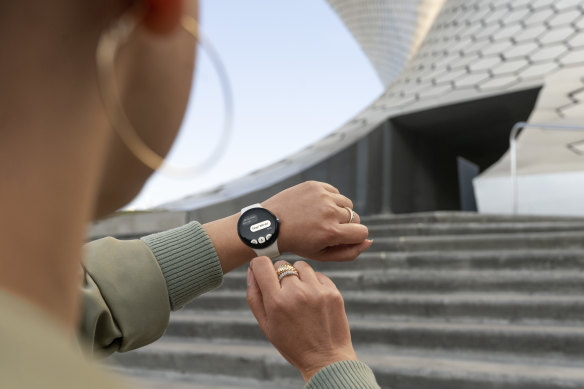
Moving to watches, the new $550 Pixel Watch is mainly exciting because it represents Google’s first effort, though it’s clearly ill-suited for a comparison with the supremely refined Apple Watch, now in its eighth generation.
The Pixel Watch is one of the slickest Wear OS watches ever, sliding smoothly between tiles and apps, boasting a range of customisable faces with Apple-style complications, ably tracking workouts and heart rates and even offering fall detection. Pretty much anything you can do with an Apple Watch you can do here, including streaming music directly to earbuds, tapping to make payments and connecting to mobile data networks (with the more expensive cellular model).

The Pixel Watch can put your messages and calls on your wrist, and track your fitness.
But Google plies its own strength on the watch too. The voice assistant and smart home apps are better than Apple’s, and the turn-by-turn Google Maps guidance is awesome for walking and cycling.
But the Apple Watch S8 (from $630) is prettier and more capable. Side by side the Pixel seems slow, and its huge black bezels are very noticeable. Apple’s fitness rings are more digestible and its tracking more complete than the solution provided by Google’s Fitbit, and the Apple Watch’s battery lasts much longer.
It’s a similar story with the Pixel Buds Pro ($300) against the second generation AirPods Pro ($400). Google is less expensive and delivers a product that beats most of its Android contemporaries, but Apple is more experienced in the category. The noise cancellation on the AirPods is more complete, the pinch controls are less prone to accidental touching, but both are comfortable and sound good.
It’s when you look at the ecosystems as a whole that you can see where the big differences are.
Loading
Apple makes small iterations each year, but it’s clearly building towards a place where its products are indispensable to navigating the real world as well as the virtual. Its introduction of an always-on display for the iPhone 14 Pro immediately leapfrogged Android’s longstanding implementation with widgets and information that help keep the phone at the centre of your communication, agenda, smart home, entertainment and fitness. Meanwhile, the expanded compass features in its Watch — which let you drop virtual markers and be guided back to them later — and decibel-lowering AirPod tech point to a desire to augment the natural world with tech in a way that would be cumbersome on a phone.
By comparison, the Pixel line has always been about Google showcasing its Android software and artificial intelligence capabilities, and we see that on the latest phones with features like the ability to transcribe voice messages, translate between languages in real time, and make sharp images out of old photos with a lot of motion blur. The move into the smartwatch space is an expansion of this, and shows how Google’s massive mapping, data and AI capabilities can be put to work on people’s wrists. As with Android on phones, this is likely to make for not only more useful Pixel devices in the future, but gear from other manufacturers leveraging (and supporting) Google software as well.



























